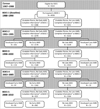Long-term use of aspirin and age-related macular degeneration
- PMID: 23288416
- PMCID: PMC3630794
- DOI: 10.1001/jama.2012.65406
Long-term use of aspirin and age-related macular degeneration
Abstract
Context: Aspirin is widely used for relief of pain and for cardioprotective effects. Its use is of concern to ophthalmologists when ocular surgery is being considered and also in the presence of age-related macular degeneration (AMD).
Objective: To examine the association of regular aspirin use with incidence of AMD.
Design, setting, and participants: The Beaver Dam Eye Study, a longitudinal population-based study of age-related eye diseases conducted in Wisconsin. Examinations were performed every 5 years over a 20-year period (1988-1990 through 2008-2010). Study participants (N = 4926) were aged 43 to 86 years at the baseline examination. At subsequent examinations, participants were asked if they had regularly used aspirin at least twice a week for more than 3 months.
Main outcome measure: Incidence of early AMD, late AMD, and 2 subtypes of late AMD (neovascular AMD and pure geographic atrophy), assessed in retinal photographs according to the Wisconsin Age-Related Maculopathy Grading System.
Results: The mean duration of follow-up was 14.8 years. There were 512 incident cases of early AMD (of 6243 person-visits at risk) and 117 incident cases of late AMD (of 8621 person-visits at risk) over the course of the study. Regular aspirin use 10 years prior to retinal examination was associated with late AMD (hazard ratio [HR], 1.63 [95% CI, 1.01-2.63]; P = .05), with estimated incidence of 1.76% (95% CI, 1.17%-2.64%) in regular users and 1.03% (95% CI, 0.70%-1.51%) in nonusers. For subtypes of late AMD, regular aspirin use 10 years prior to retinal examination was significantly associated with neovascular AMD (HR, 2.20 [95% CI, 1.20-4.15]; P = .01) but not pure geographic atrophy (HR, 0.66 [95% CI, 0.25-1.95]; P = .45). Aspirin use 5 years (HR, 0.86 [95% CI, 0.71-1.05]; P = .13) or 10 years (HR, 0.86 [95% CI, 0.65-1.13]; P = .28) prior to retinal examination was not associated with incident early AMD.
Conclusions: Among an adult cohort, aspirin use 5 years prior to observed incidence was not associated with incident early or late AMD. However, regular aspirin use 10 years prior was associated with a small but statistically significant increase in the risk of incident late and neovascular AMD.
Conflict of interest statement
Figures
Comment in
-
Aspirin use and risk of macular degeneration.JAMA. 2013 Mar 27;309(12):1226. doi: 10.1001/jama.2013.2038. JAMA. 2013. PMID: 23532230 No abstract available.
-
Aspirin use and risk of macular degeneration.JAMA. 2013 Mar 27;309(12):1227. doi: 10.1001/jama.2013.2035. JAMA. 2013. PMID: 23532231 No abstract available.
-
Aspirin use and risk of macular degeneration--reply.JAMA. 2013 Mar 27;309(12):1227-8. doi: 10.1001/jama.2013.2041. JAMA. 2013. PMID: 23532232 No abstract available.
References
-
- Soni A. Agency for Healthcare Research and Quality. Rockville, MD: 2007. Aspirin Use among the Adult U.S. Noninstitutionalized Population, with and without Indicators of Heart Disease, 2005. Statistical Brief #179.
-
- U.S. Food and Drug Administration. [Accessed January 17, 2012];Aspirin: Questions and Answers. http://www.fda.gov/drugs/resourcesforyou/consumers/questionsanswers/ucm0....
-
- el Baba F, Jarrett WH, Harbin TS, Jr, et al. Massive hemorrhage complicating age-related macular degeneration. Clinicopathologic correlation and role of anticoagulants. Ophthalmology. 1986;93(12):1581–1592. - PubMed
-
- Kiernan DF, Hariprasad SM, Rusu IM, et al. Epidemiology of the association between anticoagulants and intraocular hemorrhage in patients with neovascular age-related macular degeneration. Retina. 2010;30(10):1573–1578. - PubMed
-
- Tilanus MA, Vaandrager W, Cuypers MH, Verbeek AM, Hoyng CB. Relationship between anticoagulant medication and massive intraocular hemorrhage in age-related macular degeneration. Graefes Arch Clin Exp Ophthalmol. 2000;238(6):482–485. - PubMed
Publication types
MeSH terms
Substances
Grants and funding
LinkOut - more resources
Full Text Sources
Other Literature Sources
Medical


